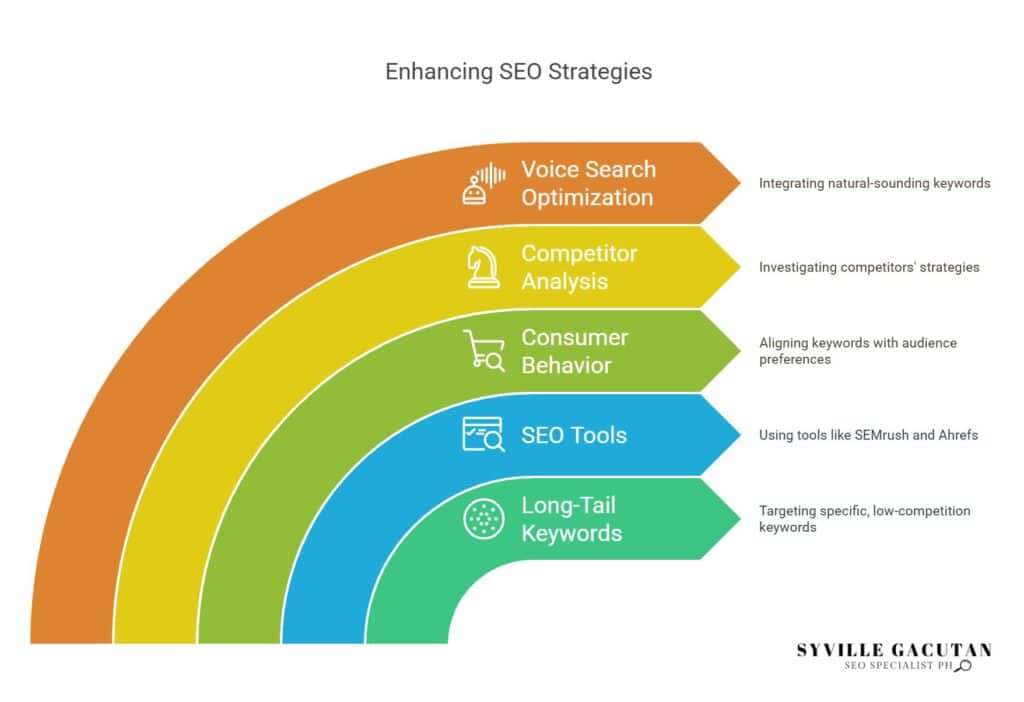
Niche Market SEO: Advanced Keyword Research Tactics
Mastering niche market SEO starts with a deep understanding of your specific audience’s needs and behaviors. By analyzing consumer behavior and segmenting your audience by demographics and online interactions, you can tailor your approach more effectively. Competitor analysis is another key technique—examining their backlinks and content strategies uncovers potential opportunities and gaps you can exploit. Incorporating semantic search principles helps ensure your content aligns with user intent, making it more relevant and valuable. Tools like SEMrush and Google Keyword Planner are essential for discovering long-tail keywords and tracking search trends. Adjusting your strategy to include voice search optimization and identifying content gaps ensures your content is well-targeted. Embracing these techniques will boost your niche marketing success, and further exploration will reveal advanced keyword research techniques for niche markets.
Key Takeaways
- Utilizing long-tail keywords with low competition: Focus on targeting specific, less competitive keywords that cater to a narrow audience, improving chances of ranking in niche markets.
- Leveraging tools like SEMrush and Ahrefs: Use these SEO tools to discover keyword opportunities tailored to your niche, analyzing search volumes and competition.
- Analyzing consumer behavior: Study how your target audience searches and buys to align your keywords with their preferences and buying patterns for better engagement.
- Conducting competitor analysis: Investigate your competitors’ strategies to uncover keyword gaps and refine your approach for a competitive edge.
- Optimizing for voice search: Integrate conversational, natural-sounding long-tail keywords to capture voice search traffic, aligning with how people speak their queries.

Understanding Niche Market Dynamics
Understanding the dynamics of niche markets involves a deep dive into the unique characteristics and specific demands of narrowly defined segments of the larger market. This requires a strategic approach, beginning with effective market segmentation strategies to accurately identify and categorize these specialized segments.
By segmenting the market, businesses can tailor their offerings to meet the distinct needs of specific groups, thereby enhancing customer satisfaction and loyalty.
Consumer behavior analysis plays a crucial role in understanding niche markets. By scrutinizing the purchasing patterns, preferences, and influences affecting consumer decisions, businesses can align their marketing efforts more closely with the expectations of their target audience.
This analysis helps in predicting future behaviors and trends, which is essential for maintaining a competitive edge in niche markets.
Niche trends exploration is another vital element, as it involves keeping a finger on the pulse of evolving market conditions and emerging consumer interests.
This proactive approach enables companies to anticipate shifts in demand and adapt their strategies accordingly. By staying ahead of trends, businesses can position themselves as leaders rather than followers, setting the stage for long-term success.
Value proposition development is central to thriving in niche markets. Crafting a compelling value proposition that resonates with the specific desires of a niche audience can differentiate a company from its competitors and drive engagement.
Identifying Your Target Audience

Pinpointing the right audience is a pivotal step following the exploration of niche market dynamics. Understanding who your potential customers are can significantly enhance the effectiveness of your SEO strategy.
Demographic profiling is the foundation of this process, involving the analysis of characteristics such as age, gender, income, education level, and geographic location. This profiling helps in crafting messages that resonate with specific groups.
User behavior, on the other hand, provides insights into how individuals interact with your content and website. By examining patterns such as pages visited, time spent on site, and conversion paths, businesses can tailor their offerings to meet the expectations and preferences of their audience.
Audience segmentation further refines this approach, allowing for the categorization of users into distinct groups based on shared characteristics. This segmentation facilitates targeted marketing efforts, ensuring that content and advertisements speak directly to the needs and interests of each segment.
Engagement metrics are indispensable in gauging the effectiveness of your communication strategies. These metrics, including likes, shares, comments, and click-through rates, offer a quantitative measure of audience interaction and satisfaction. Understanding these metrics aids in refining content strategies for better engagement.
- Demographic Profiling: Evaluate age, gender, income, and location.
- User Behavior: Analyze interaction patterns and preferences.
- Audience Segmentation: Categorize users into tailored groups.
- Engagement Metrics: Measure interaction through likes, shares, and clicks.
Intent analysis is the final piece of the puzzle. By discerning what users aim to achieve, whether it’s informational, navigational, or transactional, businesses can better align their content to fulfill these objectives, ultimately driving successful engagement and conversions.
Competitor Analysis Techniques
How can businesses gain a competitive edge in a crowded niche market? One effective method is through comprehensive competitor analysis. Understanding the landscape of your niche begins with identifying competitor strengths and weaknesses. By scrutinizing their keyword clustering, businesses can uncover which terms drive traffic and engagement for competitors, offering insights into effective keyword strategies that can be adopted or adapted.
Content strategies play a pivotal role in distinguishing a company from its competitors. Evaluating the types of content that competitors produce, such as blogs, videos, or infographics, and their performance metrics can guide businesses in developing distinctive and appealing content. Analyzing how competitors structure their content and which topics resonate with audiences provides a roadmap for effective content creation and distribution.
Backlink analysis is another crucial component. By examining the backlink profiles of competitors, businesses can identify high-quality sources of backlinks that contribute to their search engine rankings. This analysis reveals opportunities to build relationships with authoritative websites and improve one’s own domain authority. Furthermore, understanding the types of content that attract backlinks can inform content creation strategies.
Market positioning is the final piece of the puzzle. By assessing how competitors position themselves within the niche, including their value propositions and branding messages, businesses can identify gaps or opportunities in the market. This understanding helps in crafting unique selling propositions that differentiate from competitors and appeal directly to the target audience.
In essence, thorough competitor analysis empowers businesses to make informed decisions, optimize their SEO efforts, and achieve a competitive edge in their niche market.
Leveraging Semantic Search

Building on the insights gained from competitor analysis, businesses can further enhance their SEO strategies by leveraging semantic search. This approach involves understanding the underlying semantic intent behind user queries, going beyond mere keyword matching to focus on context and meaning. By aligning content with user context, brands can satisfy search engine algorithms that prioritize content relevancy. This alignment not only improves search rankings but also enriches user experience.
Semantic search requires a nuanced approach to keyword research, emphasizing keyword variations. Instead of fixating on one set of keywords, businesses should consider synonymous terms and related phrases that reflect the multifaceted nature of user searches. This ensures that content addresses diverse user intents, covering a broader spectrum of potential queries.
Understanding semantic intent is pivotal in crafting content that resonates with audiences. Search engines are increasingly adept at discerning the nuances of language and context. For businesses, this means ensuring their content is rich, comprehensive, and contextually aligned with user expectations. By doing so, they can effectively communicate to both search engines and users alike.
Here are key considerations when leveraging semantic search:
- Semantic intent: Focus on the purpose behind user queries to tailor content that meets specific needs and expectations.
- Keyword variations: Employ a diverse range of related terms to capture the full scope of potential searches.
- User context: Consider the circumstances and backgrounds that drive user searches to create relevant, engaging content.
- Search engine algorithms: Stay informed about algorithm changes to maintain content relevancy and visibility.
Tools for Niche Keyword Research

Identifying effective tools for niche keyword research is crucial for businesses aiming to enhance their SEO strategies in specialized markets. These tools assist in uncovering valuable insights that go beyond basic keyword identification, enabling marketers to develop keyword clustering strategies tailored to specific audiences.
Tools such as SEMrush and Ahrefs are particularly adept at revealing long tail keywords, which are essential for capturing niche market searches with lower competition yet high conversion potential.
Google Trends is another indispensable tool, providing data on seasonal trends that can shape content strategies around peak interest periods. Understanding these trends allows businesses to align their SEO efforts with consumer behavior, ensuring content remains relevant and timely.
Furthermore, Google Trends can help decipher search intent by highlighting the context in which certain keywords are used, thus enabling marketers to craft content that precisely addresses user queries.
Local SEO is another critical aspect of niche market research, especially for businesses seeking to dominate regional markets. Tools like Moz Local and BrightLocal provide insights into local search patterns, helping businesses optimize their presence in specific geographic areas.
These platforms offer features such as local rank tracking and competitor analysis, ensuring that strategies are fine-tuned to meet local consumer needs.
Optimizing for Voice Search

In the evolving landscape of digital marketing, optimizing for voice search is becoming increasingly essential for businesses targeting niche markets. As the prevalence of smart devices grows, voice assistant usage is surging, necessitating a shift in SEO strategies. Understanding voice search trends can significantly enhance a business’s visibility within its niche by aligning with the way users naturally interact with technology.
To effectively optimize for voice search, businesses should focus on conversational queries, which differ markedly from traditional text-based searches. These queries are typically longer and mimic natural speech patterns, thereby requiring the integration of long tail keywords into content strategies. This adaptation can make a significant difference in capturing traffic from voice searches, which often involve more specific and localized inquiries.
Local optimization plays a critical role in voice search SEO, as a substantial proportion of voice searches have local intent. Ensuring that business information is accurate and consistent across all platforms can improve local search rankings and increase visibility to potential customers in the area.
Furthermore, optimizing for local search can provide a competitive edge in niche markets by capturing the attention of consumers seeking nearby solutions.
- Understand the nuances of conversational queries: Recognize how users frame their questions to tailor content that addresses these specific queries.
- Incorporate long tail keywords: Focus on more detailed keyword phrases that align with natural language to capture niche market traffic.
- Leverage local optimization: Optimize business listings and content for local search intent to enhance visibility.
- Monitor voice search trends: Stay updated on how voice search is evolving to adjust strategies accordingly.
Content Gap Identification

As businesses refine their SEO strategies to align with voice search trends, another key component emerges: content gap identification. This process involves analyzing existing content to uncover gaps that inhibit meeting user needs effectively. Identifying these content gaps is crucial for optimizing a website’s content strategy, ensuring that it aligns with the evolving search trends and user expectations.
Understanding keyword intent is paramount when identifying content gaps. Keyword intent reveals the purpose behind a user’s search query, whether it’s informational, navigational, or transactional. By aligning content with keyword intent, businesses can address specific user needs more precisely, enhancing the overall user journey. This alignment not only increases engagement but also improves search engine rankings, as content becomes more relevant to what users are actively seeking.
A comprehensive content strategy should incorporate a thorough analysis of competitor content to identify areas where your content may be lacking. Tools such as content gap analysis software can be employed to discover what competitors are ranking for that your site isn’t. This analysis can uncover untapped opportunities to create content that fulfills unmet user needs, thereby closing the content gaps.
Moreover, keeping abreast of search trends is essential. Trends can indicate shifts in user behavior and emerging topics of interest. By staying informed, businesses can proactively address content gaps by producing timely and relevant content that resonates with their audience.
Final Thoughts
Mastering niche market SEO requires a blend of precise keyword research, competitor analysis, and an understanding of audience behavior. By leveraging tools like SEMrush, Ahrefs, and Google Trends, businesses can uncover valuable keyword opportunities and align their content strategies with user intent. It’s important to focus on optimizing for voice search and addressing content gaps to stay ahead of the competition.
If you’re ready to dominate your niche market with advanced SEO strategies, connect with Syville Gacutan, an experienced SEO Specialist in the Philippines. Syville can help you master keyword research, refine your content strategy, and boost your search engine rankings. Don’t miss the opportunity to achieve niche market success—reach out today!